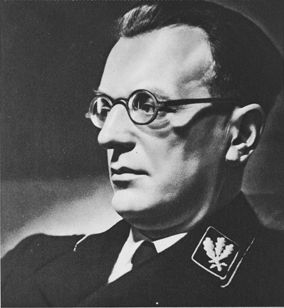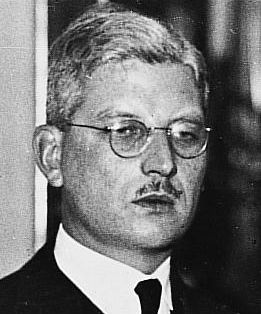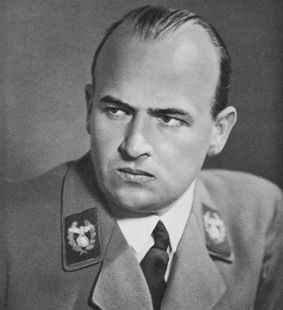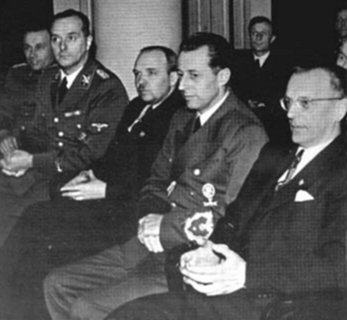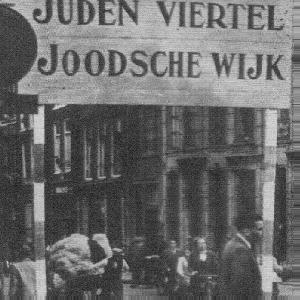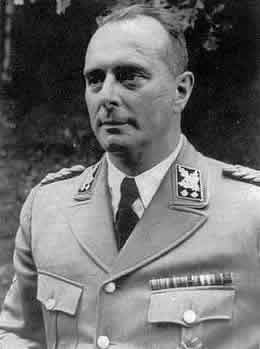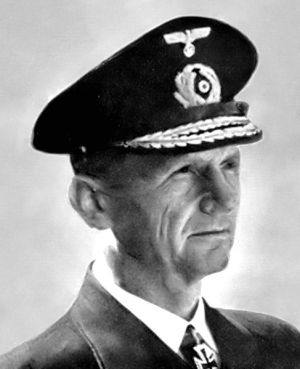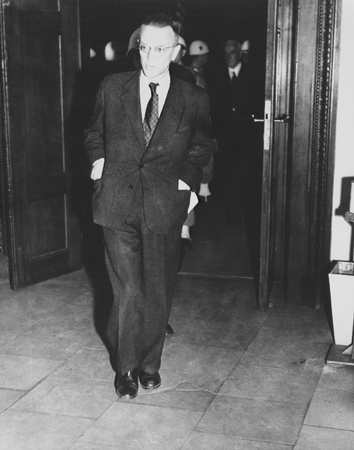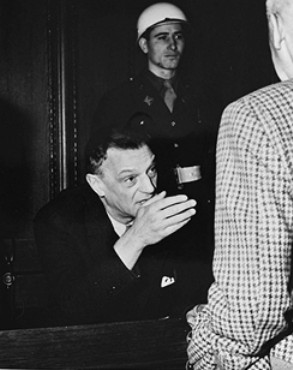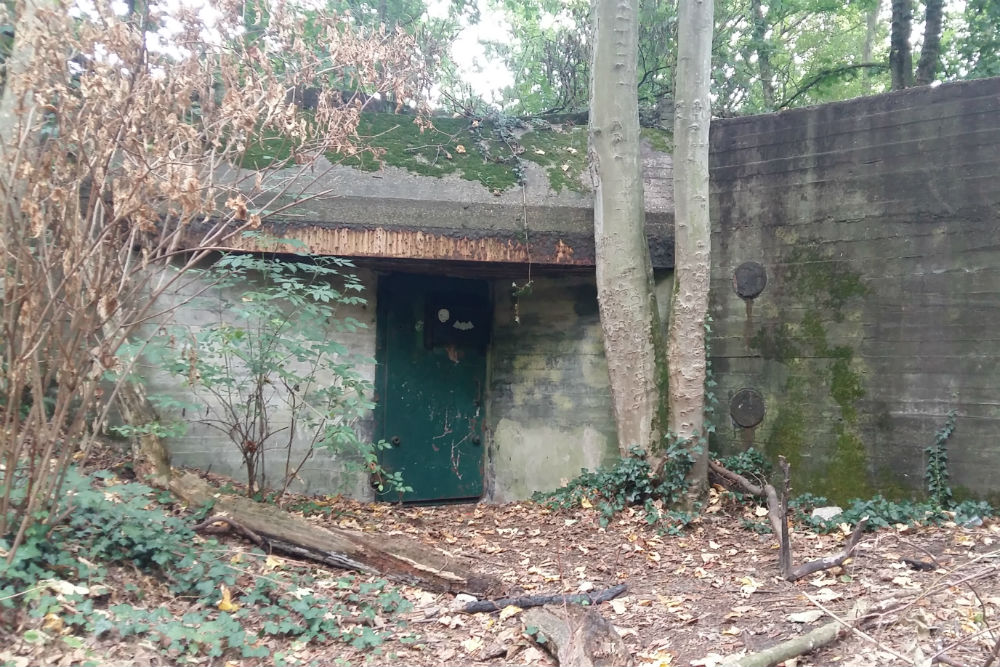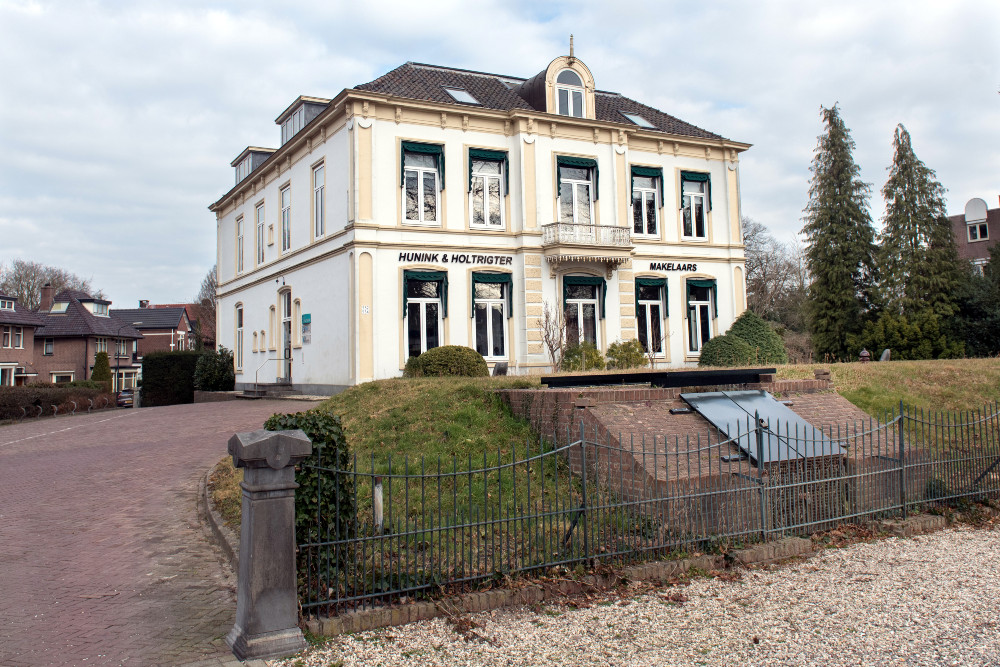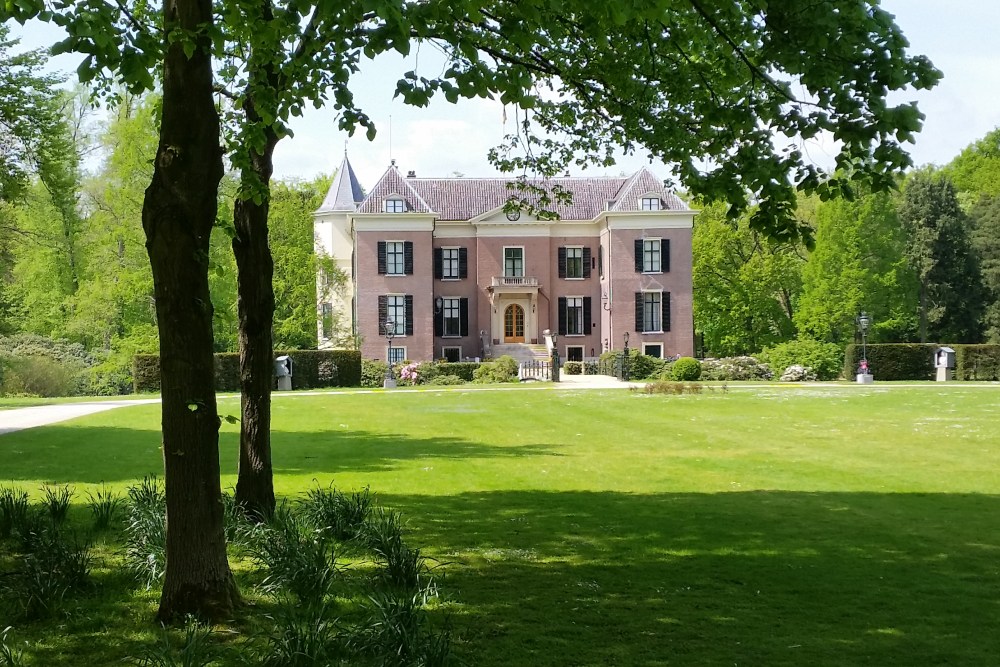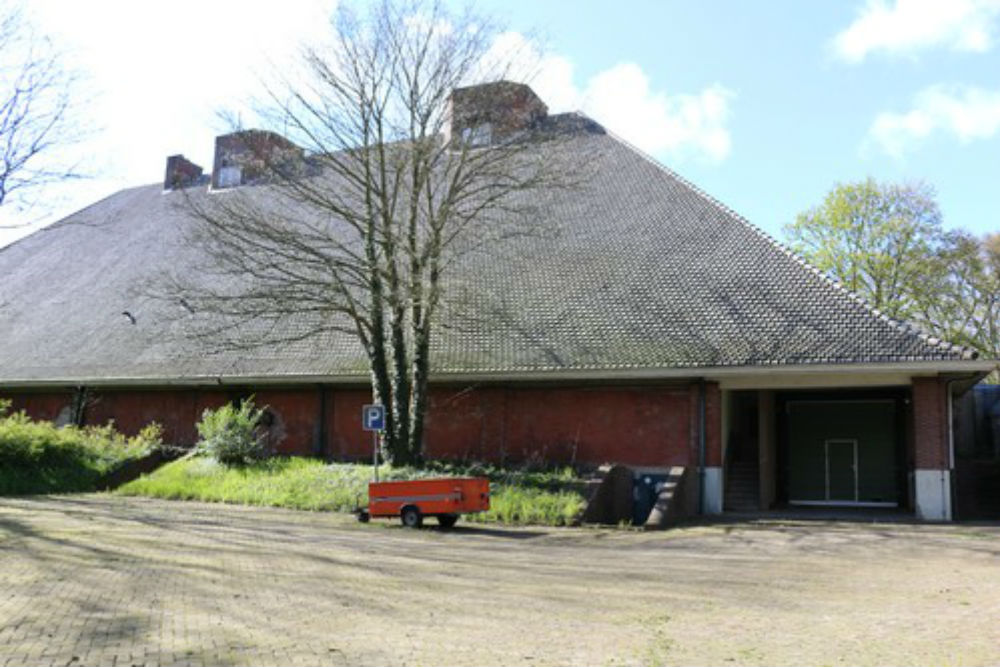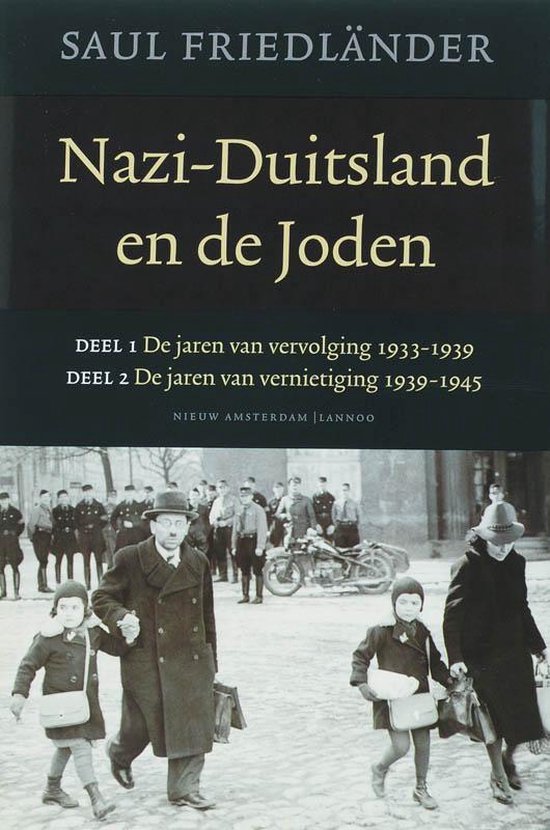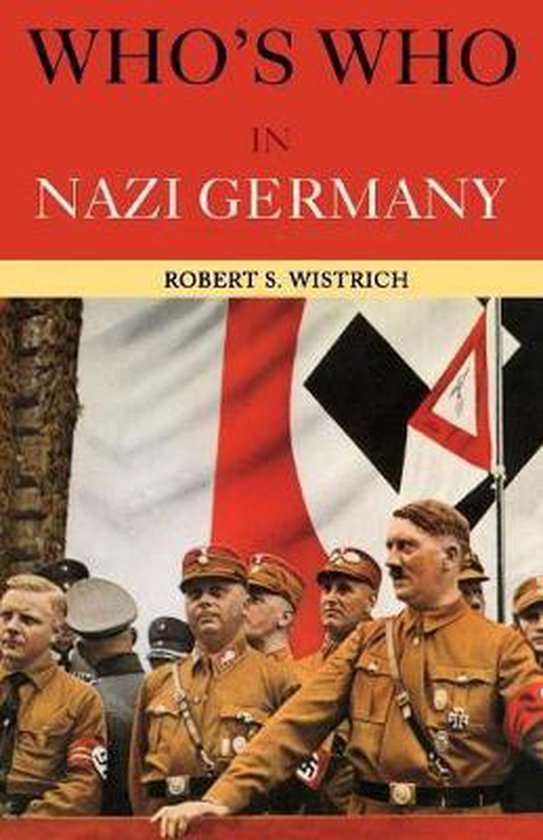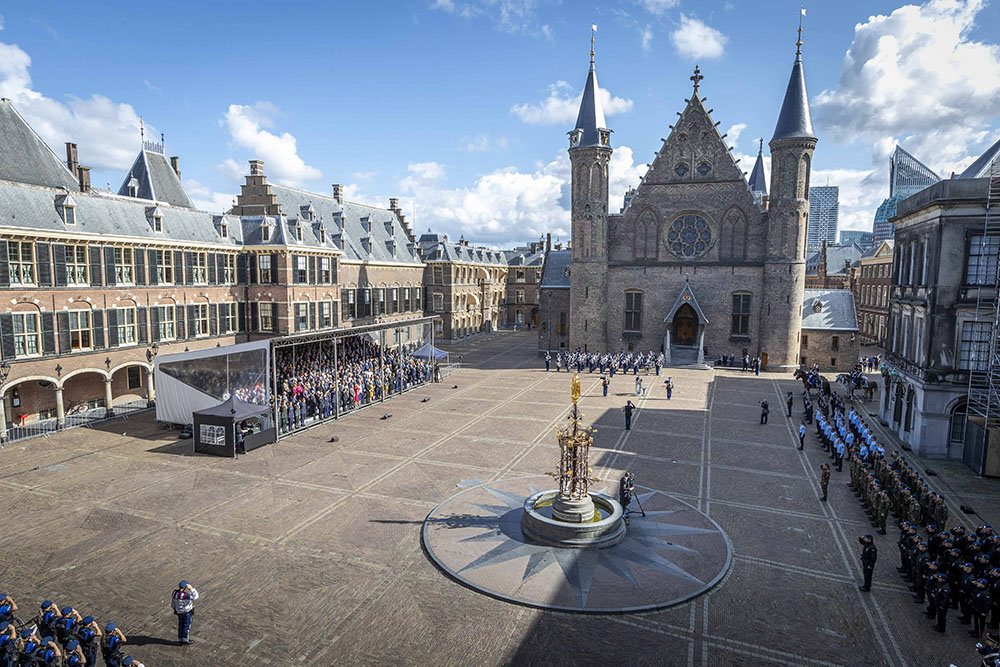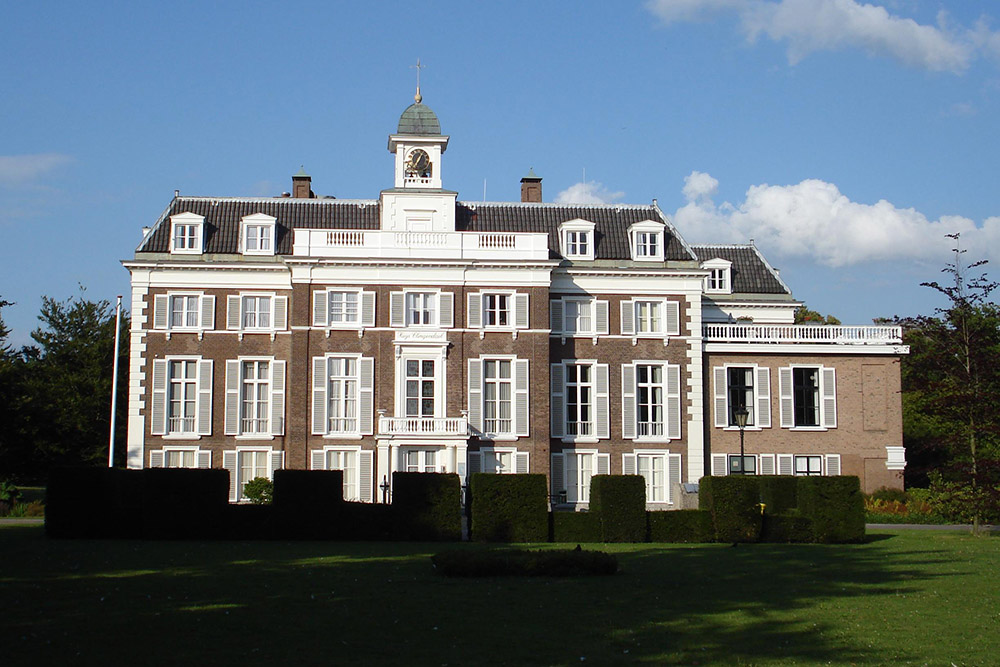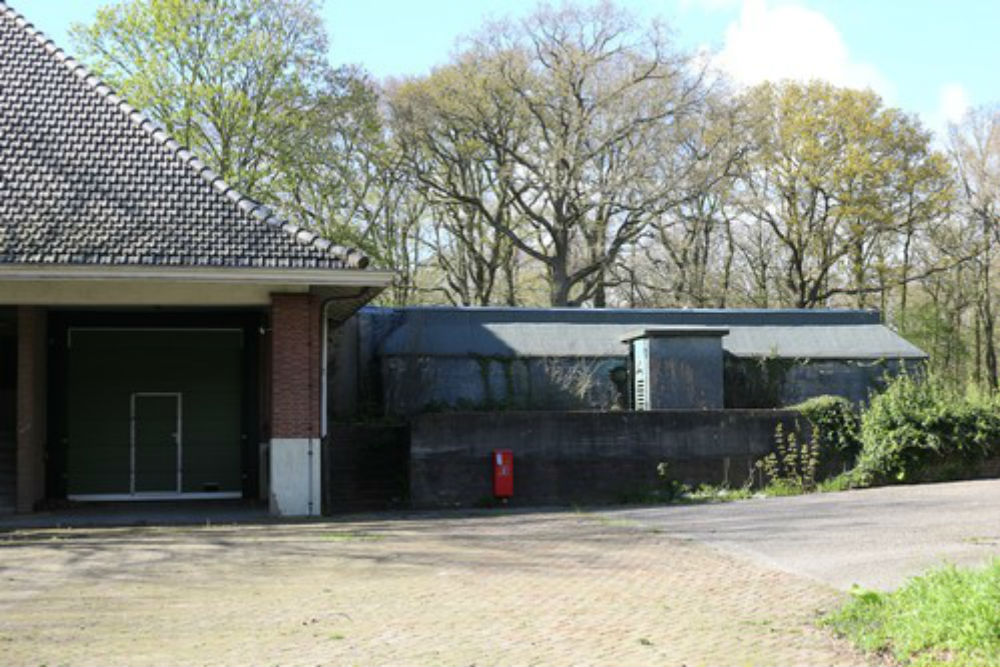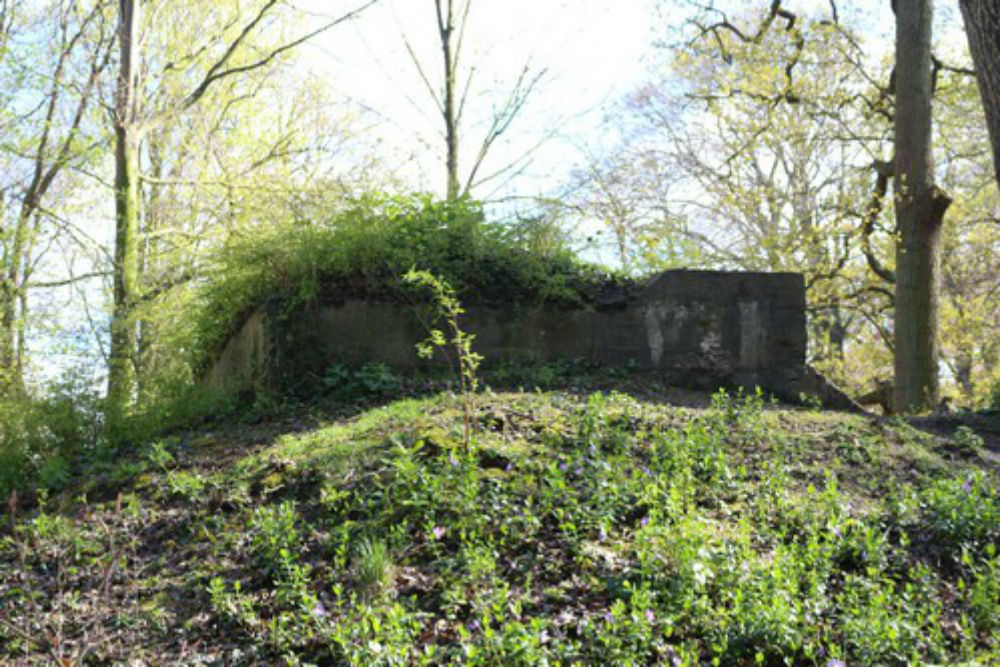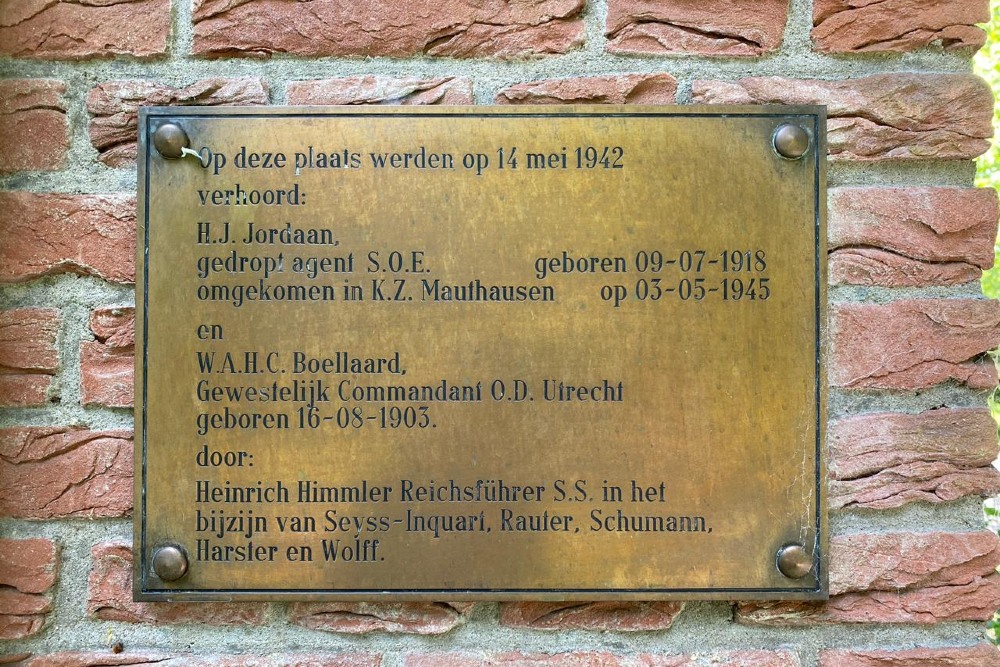Introduction
Arthur Seyss-Inquart is best known as Reich Commissioner for the occupied Netherlands. Prior to holding the function of the highest representative of the occupying forces in the Netherlands, from 1940 to 1945, he also held an important position in Austria and Poland, within the national socialistic government. In Austria, he had an important role in the unification of that country with Germany in 1938, the so called Anschluss (connection).
Throughout his career, he exerted seemingly contradictory politics. On the one hand, he was the intellectual who advocated a relatively moderate policy; on the other hand he appeared to be a fanatic national socialist, who believed that everything, church, family and an own opinion, had to give way to people, empire and Führer . The intention of this very editorial is to show both faces of Seyss-Inquart, underscoring in particular the period he was active in the Netherlands.
Definitielijst
- Anschluss
- The joining of Austria to Germany. The annexation of Austria by Nazi Germany on 12 March 1938. Austria became part of Greater Germany.
- Führer
- German word for leader. During his reign of power Adolf Hitler was Führer of Nazi Germany.
Images
Youth and World War I
Arthur Seyss-Inquart was born on July 22nd, 1892 during a holiday of his parents in the Moravian village of Stannern (Stonarov), near the city of Iglau (Jihlava). At that time, his birthplace still belonged to the Austro-Hungarian monarchy. At his birth, Arthur's father worked as a teacher of classical languages at the German gymnasium in Iglau. Shortly thereafter he was appointed principal of a German gymnasium in Olmütz. In both towns lived Sudeten Germans, who clung to the German language and culture instead of the Czech. Seyss-Inquart's family belonged to that very ethnic group. Actually, Arthur's father had a Czech surname (Zajtich), but when the family moved to Vienna in 1907, he changed the name into the German sounding Seyss-Inquart ("Inquart" came from an mother’s uncle).
Arthur was the youngest in the family of five children of which one boy died as a baby: three girls and three boys. The boys had a catholic upbringing, while to the girls were raised according to the Lutheran doctrine, as his catholic father agreed upon with his Lutheran mother.
Despite their strong preference for the German language and culture Arthur's father encouraged his wife and children to learn Czech. Arthur refused this, which could be the reason why he, frequently, was in conflict with his Czech peers. Arthur made a quite sequestered impression on his classmates. He had difficulties with befriending, was taciturn and uncommunicative and he rather studied than being engaged in mischief.
When he was sixteen, his father got retired and the family moved to Baden, south of Vienna. That is where the serious young man graduated from high school with excellent results and subsequently, in 1910, he studied law in Vienna. Meanwhile, his German nationalist feelings had highly developed. He wrote a letter to one of his sisters, still before taking his finals at high school. He wrote about his love for the German nation, for which he wanted to work as a politician. "While doing that, it will be better not to have any feelings" he wrote; "therefore I aim to suppress all feelings, so that, in cases where common sense is needed, I only will take advantage and disadvantage into consideration."
Even before Austria-Hungary announced general mobilization, in July 1914, Arthur volunteered for the army. He was assigned to the regiment of the Tiroler Kaiser Jäger and as a part of that regiment, he mostly fought on the Italian front. He served at the front from March 1915 to October 1916 and from May 1917 to November 1918. In the time in between, in December 1916, he got married to Gertrud Máschka, an Austrian general's daughter. With her he had three children (one son and two daughters). In the same period of leave in which he married, he obtained his doctorate in law. He obtained the rank of Oberleutnant and, during the First World War, he got seriously injured once. Also he was distinguished for bravery, several times. As he stated himself, his anti-Semitism developed in this very period. This was not rare for the frontal generation, many of whom attributed the defeat in 1918 to Judaism.
After 1918, Seyss-Inquart returned to Vienna where he, as a lawyer, joined a law firm. Subsequently, in 1921, he opened a private law practice. His taciturnity was more of an advantage than a disadvantage, because by keeping silence he could wait for the opportune moment to say in a few words what had to be said. The lawyer managed to establish a good living for his family. Since he supported the connection of Austria and Germany, politics still got his attention. At that time, he was not a member of a political party, but he had contacts within nationalistic catholic quarters and in 1925 he became a board member of the German-Austrian People's League, a party association that was committed to the merger of Germany and Austria. He also became a member of the Steirische Heimatschutz, an extremely right-winged, anti-Semitic and anti-Marxist paramilitary organization. It was in this strong German nationalist environment, when he met his friend Hans Fischböck, who, at that time, was director of an insurance company. During WWII he was to become general commissioner of Finance in the Netherlands, reporting to Seyss-Inquart.
Definitielijst
- First World War
- Took place from 1914 till 1918 and is also named The Great War. The conflict started because of increased nationalism, militarism and neo-colonialism in Europe. Two alliances battled one another during the 4-year war, which after a dynamic start, resulted into static trench warfare. The belligerents were the Triple Alliance (consisting of Great-Britain, France, and Russia; later enlarged by Italy and the USA, amongst others) on the one hand and the Central Powers (consisting of Germany, Austria-Hungary, Bulgaria and the Ottoman empire) on the other hand. The war was characterized by the huge number of casualties and the use of many new weapons (flamethrowers, aircraft, poison gas, tanks). The war ended in 1918 when Germany and its allies surrendered unconditionally.
- Jäger
- Also called fighter plane. Fighter planes can be used for air defence (armed with guns and/or carrying guided missiles) or for tactical purposes (armed with nuclear or conventional bombs or rockets). The aircraft used for tactical purposes are also called fighter- bombers because they are bombers with the speed and manoeuvrability of a fighter. Tactical fighters, equipped with photographic equipment are also used as reconnaissance plane.
- Judaism
- Monotheistic religion developed among the ancient Hebrews.
- mobilization
- To make an army ready for war, actually the transition from a state of peace to a state of war. The Dutch army was mobilized on the 29 August 1939.
- regiment
- Part of a division. A division divided into a number of regiments. In the army traditionally the name of the major organised unit of one type of weapon.
- Sudeten Germans
- Name for over 3,000,000 Germans living near the border of Czechoslovakia until 1945.
Austrian Nazis
In July 1934 the Austrian Nazis committed a coup, in which federal chancellor Engelbert Dollfuss was killed. The coup failed, Dollfuss was succeeded by Kurt Schuschnigg. This violent attempt to seize power and thus to unite Austria with Germany, was not the preferred way of Arthur Seyss-Inquart. Although he had the same goals as the Austrian Nazi Party, founded in 1926, he chose a more diplomatic, patient way to achieve his goal. Nevertheless, since 1931, he had contacts with Austrian Nazis, who were operating illegally since their party was banned in July 1933.
Even Adolf Hitler, in power in Germany since January 1933, endeavoured a reconciliation of Austria with his Reich. Just as, after his failed coup in 1923, he renounced a violent revolution, he understood that the Anschluss of Austria could best be achieved through a more political way. After he first had built a strong dominant position in Germany, in 1936 he had reoccupied the Rhineland, which first had to be accepted by other countries. In the meantime he did not want to create international commotion. In 1936 as well as 1937, he urged the Austrian Nazis constantly to proceed carefully. Austria was to be drawn towards Germany gradually. In this, the German dictator, did foresee an important role for Seyss-Inquart.
After the war, an American newspaper called Seyss-Inquart, Hitler's Trojan horse, thus alluding to his role in the Anschluss of Austria. In June 1937 he was appointed Staatsrat, by Schuschnigg, at the insistence of Germany. In that position he was the liaison between the acting government, which aspired maintaining the independence of Austria, and the national socialistic opposition, which strived for a union between Austria and Germany. From the perspective of Schuschnigg, Seyss-Inquart had to gain the support of the Nazis for his government. Seyss-Inquart failed in this, because most Austrian Nazis did not like the restrained policy regarding the Anschluss, which was carried out now. Because of its apparent association with the hated government, they considered Seyss-Inquart to be a double-faced opportunist.
However Hitler continued his policy and on February 12th, 1938, a meeting was held in Berchtesgaden, between him and the Austrian chancellor. Under threat of invasion by the German Wehrmacht, Hitler stated several requirements to Schuschnigg, who granted them in the days thereafter. The Austrian national socialistic party was legalized, the Nazis which had been imprisoned were released and all measures against them were withdrawn. On Hitler's wish, Seyss-Inquart joined the Austrian government on February 16th, 1938, as minister of Internal Affairs with control over police and national security.
Again, Seyss-Inquart's apparent willingness to compromise with the government, was not accepted by many Austrian Nazis. They responded to his appointment by breaking all the windows of the German embassy in Vienna. Many Austrians thought it was now time for concrete action and Seyss-Inquart had great difficulty in restraining their radicalism.
On March 9th, 1938, Schuschnigg announced a plebiscite, containing such kind of questions that the Austrians had no other option than to give their consent to the Austrian independence. This really was the last straw for Hitler. On March 11th at 10 o’clock, he did sent Schuschnigg an ultimatum, in which Hitler insisted on a postponement of the plebiscite and an adjustment of the questions in such a way that the voters were asked if they approved or disapproved of the unification with Germany. Schuschnigg was willing to postpone the plebiscite, but yet refused to resign and to leave his position to Seyss-Inquart, which was also one of the demands of Hitler.
That very day, Seyss-Inquart had a telephone conversation with Hermann Göring, who gave him the instruction to insist with the Austrian head of state, President Wilhelm Miklas, on the resignation of Schuschnigg. If this was not to happen, " the same night an invasion would follow by troops, already mobilized at the border, which would mean the end of Austria," as urged Goering with Seyss-Inquart, "you must have the national socialists have their way across the country. Tell them that they are free to go into the streets everywhere ". As a result of all German pressure, Schuschnigg resigned at 15:30, but President Miklas still refused to appoint Seyss-Inquart as chancellor. That night there were Nazi demonstrations all over Austria and at midnight, President Miklas gave in and appointed Seyss-Inquart as the successor of Schuschnigg.
Meanwhile, Wilhelm Keppler, head of the Austrian office of the NSDAP, filed a formal request to Germany in order to re-establish order in Austria. On March 12th,1938, at 5:30 AM German troops crossed the Austrian border, with official approval of Seyss-Inquart. There was no resistance; on the contrary, the German troops were welcomed by cheering Austrians.
That same day, Hitler visited Austria. In his birthplace, Braunau am Inn, he was greeted by a festive crowd. That evening he was in Linz welcomed by Seyss-Inquart, Heinrich Himmler and other leading Nazis. Seyss-Inquart, due to his role in Austria, was appointed SS Gruppenführer in Austria by Himmler. This position was similar to the army rank of lieutenant-general. Together with his government the new chancellor was working towards the formal Anschluss (annexation). On March 13th, Seyss-Inquart took over the power of attorney from President Miklas, who resigned in protest. That night a bill, allowing the annexation of Austria,was accepted by his government and signed by Hitler, which made the annexation of Austria a fact. Austria no longer existed, but was now part of the German Reich under the name of Ostmark. Seyss-Inquart was assigned to the function of Reichsstatthalter (imperial stadholder) in a new part of the German Reich. On March 15th, 1938, Hitler was welcomed to Vienna with a speech. "Where countless millions of the best Germans have bled and died for; which was the highest goal in bitter struggle and the last consolation in the most bitter hours, has now been accomplished. The Ostmark has returned. The German Reich is reborn; the ethnic Third Reich was created".
At a rapid pace, the equalization in the Ostmark was achieved, to which mainly Jews fell victim. They got to endure the same anti-Semitic measures in a few weeks, which had been carried out in Germany in the past five years. Many of them were imprisoned or were made victims of brutal harassment by Nazi sympathizers. It seems that Seyss-Inquart was shocked by the aggression against the Jews. He helped some Jewish families, he was acquainted with, with their emigration. He was worried more about the public violence rather than of the anti-Semitism, since his administration had been working actively to the introduction of anti-Semitic laws. In Vienna, 1938, he opened, together with Odilo Globocnik, the anti-Semitic exhibition "Der ewige Jude" (the eternal Jew).
As Reichsstatthalter, Seyss-Inquart still was not popular among many Austrian Nazis. In his position of power, he was restricted by Josef Burckel, the Gauleiter ( governor) of the Saarpfalz, who was appointed as deputy for the future plebiscite in the Ostmark and also Reichskommissar for the unification between Austria and Germany. Burckel was influenced by Seyss-Inquart’s old enemies within the NSDAP. Despite his problems with that party, Seyss-Inquart became a member on May 13th, 1938. One year later, on May 1st 1939, the Austrian government was dissolved and Seyss-Inquart was appointed Reichsminister in the German government, without portfolio. Because this government had never been convened by Hitler at that time, in this function he had little to do. However, this appointment meant an increase of status. Moreover, his appointment presented practical advantages, like an own liaison office in Berlin with a small staff and a fund for secret expenses of 100,000 Reichsmark per month. Shortly after the break out of World War II in September 1939, a new assignment in Poland was waiting for Seyss-Inquart.
Definitielijst
- Gauleiter
- Leader and representative of the NSDAP of a Gau.
- invasion
- Armed incursion.
- Jews
- Middle Eastern people with own religion that lived in Palestine. They distinguished themselves by their strong monotheism and the strict observance of the Law and tradition. During World War 2 the Jewish people were ruthlessly persecuted and annihilated by the German Nazis. . An estimated 6,000,000 Jews were exterminated.
- Nazi
- Abbreviation of a national socialist.
- Reichskommissar
- Title of amongst others Arthur Seyss-Inquart, the highest representative of the German authority during the occupation of The Netherlands.
- resistance
- Resistance against the enemy. Often also with armed resources.
- revolution
- Usually sudden and violent reversal of existing (political) the political set-up and situations.
- Rhineland
- German-speaking demilitarized area on the right bank of the Rhine which was occupied by Adolf Hitler in 1936 after World War 1.
- Wehrmacht
- German armed military forces, divided in ground forces, air force and navy.
Images
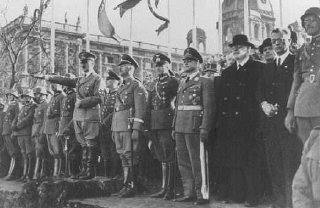 Adolf Hitler salutes a military parade in Vienna after the Anschluss. Seyss-Inquart is the second person from the right. Source: www.doew.at.
Adolf Hitler salutes a military parade in Vienna after the Anschluss. Seyss-Inquart is the second person from the right. Source: www.doew.at.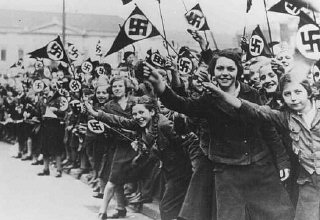 Girls from the Bund Deutscher Mädel in Vienna celebrate the Anschluss of Austria. Source: www.doew.at.
Girls from the Bund Deutscher Mädel in Vienna celebrate the Anschluss of Austria. Source: www.doew.at.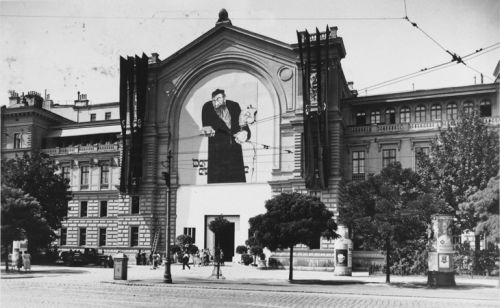 Der Ewige Jude in Vienna, 1938. The exposition was opened by Seyss-Inquart and Odilo Globocnik. Source: USHMM.
Der Ewige Jude in Vienna, 1938. The exposition was opened by Seyss-Inquart and Odilo Globocnik. Source: USHMM.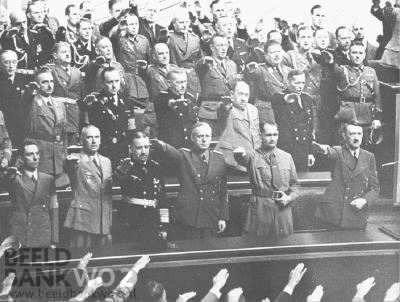 Members of the German parliament. Seyss-Inquart is standing in the third row from below, third from the right. Source: Beeldbank WO2.
Members of the German parliament. Seyss-Inquart is standing in the third row from below, third from the right. Source: Beeldbank WO2.General government
On September 1st,1939, German troops invaded Poland. After the Polish army had been vanquished, a part of the land was annexed by Germany, while another part was subjected to an occupying power in the form of German civil administration. This occupied area was called the Generalgouvernement, controlled by Generalgouverneur Hans Frank. On October 12th, Seyss-Inquart was appointed as his deputy. Before that time, here he already had been head of the civil section of the Militärverwaltung (military government) during one month.
The occupation was immediately accompanied by much brutality, amongst others, against the Polish intelligentsia and the Jews. It was a deliberate policy that was conducted by the Germans, because the Polish people were not considered as being adequate citizens, but rather like a workforce that was at governmental disposal. "The most important guideline in the implementation of the German administration in the Generalgouvernement must exclusively be in the interest of the German Reich", as spoke Seyss-Inquart to the staff of the Generalgouvernement ", during a mission in Poland by the end of 1939. "A tough and correct administration has to make the area productive for the German economy. In order to avoid excessive generosity, one has to bear in mind, the possible effect of an invasion of the Poles in the German area".
The Generalgouvernement also played an important role in the completion of the Endlösung der Judenfrage (final solution to the Jewish issue), the extermination of European Jews by the Nazis. During the time that Seyss-Inquart was active in the Generalgouvernement, there was no question of a mass extermination and the death camps had yet to be established. Nevertheless, he already came into contact with the "Jewish question", because he was responsible for the inspection of the area where the so-called Nisko and Lublin plan should be implemented. The plan consisted of the removal of Jews within the "Reich" to a Jewish reservation near Lublin. Nisko was designated as the location of a transit camp. After his inspection Seyss-Inquart reported his findings in November 1939. "According to Schmidt, the governor of the district, this swampy area is very well suited for a Jewish reservation", as he stated, "in fact, it may, in itself, lead to a significant decimation of the Jews." Some deportations to Lublin were carried out, but in April 1940 the operation was put to an end.
Seyss-Inquart was not satisfied with his job in the Generalgouvernement, he had too little responsibility, which did not fully meet his capacities. Moreover, many of his old enemies from the Austrian Nazi party occupied senior posts in the Generalgouvernement and he was distrusted and opposed by them. That was the reason why he, by mail, asked Hitler on May 10th, 1940, for a transfer. He preferred to be sent to the front, although he was limping as a result of an accident while climbing the Ortler in Tirol in 1928, where he shattered his left kneecap. He thought his experience from World War I could come in handy in this transfer.
However Hitler did have another plan in mind and had him sent to the Netherlands, which had been invaded by German troops on May 10th 1940, and capitulated four days later. After he learned that he was to be transferred to the Netherlands, Seyss-Inquart phoned his wife. "The Führer wants me to plant tulips. Be prepared", so he told her. Besides the fact that he associated the Netherlands with tulips, he knew hardly anything about this country. At his parting from the Generalgouvernement, he declared that actually his heart was in the east. "I'm going to the west and I want to be very honest: I'm here with my heart," he stated, "because I am oriented to the east into my deepest. In the east we do have a national socialist mission, yonder, in the west, we have a function. That might be a difference".
Definitielijst
- Endlösung
- Euphemistic term for the final solution the Nazis had in store for the “Jewish problem”. Eventually the Endlösung would get the form of annihilating the entire Jewish people in extermination camps.
- Führer
- German word for leader. During his reign of power Adolf Hitler was Führer of Nazi Germany.
- Generalgouvernement
- That part of Polish territory occupied by the Germans in 1939. It was an autonomous part of Greater Germany. In August 1941 Eastern Galicia was added to the Generalgouvernement. It was governed solely by Germans under direction of Generalgouverneur Hans Frank. It was to become a full German province inhabited only by German colonists.
- invasion
- Armed incursion.
- Jews
- Middle Eastern people with own religion that lived in Palestine. They distinguished themselves by their strong monotheism and the strict observance of the Law and tradition. During World War 2 the Jewish people were ruthlessly persecuted and annihilated by the German Nazis. . An estimated 6,000,000 Jews were exterminated.
- Nazi
- Abbreviation of a national socialist.
Images
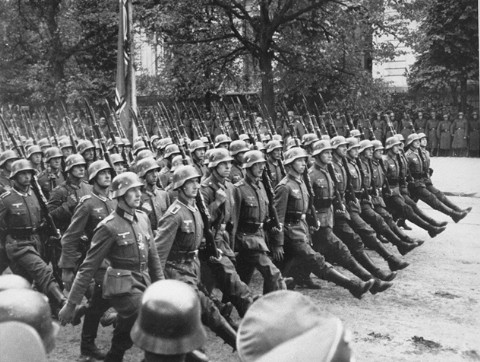 German soldiers march through Warsaw in honor of the German victory in Poland. Source: USHMM.
German soldiers march through Warsaw in honor of the German victory in Poland. Source: USHMM.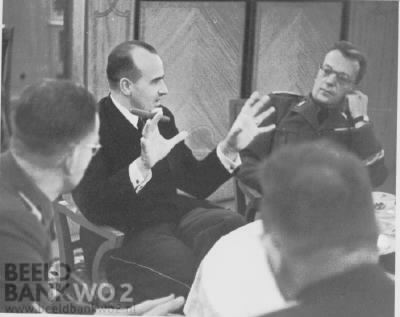 Hans Frank and Seyss-Inquart. This photo was taken during a visit of the governor to the Netherlands. Source: Beeldbank WO2.
Hans Frank and Seyss-Inquart. This photo was taken during a visit of the governor to the Netherlands. Source: Beeldbank WO2.Appointment in the Netherlands
From May 29th, 1940, until the end of the war, Seyss-Inquart was Reichskommissar für die besetzten Niederlände (Reich Commissioner for occupied Netherlands). In that position he was formally the highest representative of the occupational administration, directly responsible to Adolf Hitler. He was supported by a staff of Generalkommissare. Two of them he himself was allowed to choose. They were his friends, Friedrich Wimmer and Hans Fischböck. Wimmer was Generalkommissar für Verwaltung und Justiz (Commissioner-general for administration and justice) and was his deputy in case he was absent. Fischbock was as Generalkommissar für Finanz und Wirtschaft responsible for finance and economic affairs.
The two staff members who were assigned to Seyss-Inquart, were Hanns Rauter and Fritz Schmidt. Rauter was as Höhere SS- und Polizeiführer (higher SS and police commissioner), subordinated to SS leader Heinrich Himmler, at the same time he was Generalkommissar für das Sicherheitswesen (Commissioner-general for safety). Schmidt had been assigned from the Nazi party and was as Generalkommissar zur besonderen Verwendung (Commissioner-general for special affairs) responsible for controlling public opinion and the nazification of public life. In the provinces and in Amsterdam and Rotterdam, Seyss-Inquart appointed a total of thirteen Beauftragte, which were local supervisors. Military issues were not his direct responsibility, since for those, Wehrmachtsbefehlshaber (supreme commander of the army)Friedrich Christiansen was in charge.
Seyss-Inquart and his Reichskommissariat took the place of the Dutch government, which had fled to London. The Secretaries-general, which were the highest governmental officials still present in the Netherlands during the occupation, were willing to cooperate with the occupying forces. This way they thought to be of more importance to the Dutch population, rather than by leaving. The Dutch Civil Service remained largely intact, but was supervised by German officials and received summons from the German occupational administration. Dutch officials had to declare in writing that they would adopt a loyal attitude towards the Germans. They also had to sign a so-called Aryan declaration; Jewish officials were dismissed. Gradually, many top management positions, including the position of mayor, were taken by NSB (the Dutch National Socialist Party)members.
The cooperation with the German occupying forces and the preservation of a large part of the Dutch civil service was only possible because of the nature of the occupation, which was different as for example in Poland. The Poles were subjected to a brutal occupation in which they were deprived of all self-government, because the Nazis regarded them as inferior people. The Dutch, however, were considered a Germanic sister nation. Hitler gave Seyss-Inquart the assignment not to suppress and exploit the Dutch and to exterminate the intelligentsia, but to win them over to national socialism and the Great German ideal. What had worked out in Austria (many Austrians welcomed the Anschluss enthusiastically), had, on the long term, to succeed in the Netherlands as well. This aim could only be realized, when the Dutch were not enslaved, but were treated as fully fledged and future citizens of the new Empire.
To emphasize this aim, Seyss-Inquart held an inaugural speech on May 29th, 1940, in the Ridderzaal (the House of Parliament) in which he explained the "peaceful" intentions of Germany. The inaugural speech of Seyss-Inquart was attended by the Dutch Secretaries-general. General Henri Winkelman, at that time the highest Dutch authority, had recommended them to accept the invitation, but to leave if the Queen was referred to in a derogative way. He himself was not invited. No derogatory remarks were mentioned about the royal family; Seyss-Inquart spoke conciliatory words and emphasized the consanguinity between the Germans and Dutch. "We have not come here to dominate this country and its nation in an imperialistic way, nor to force our political beliefs. We only want our actions to be guided by the necessities, arising from the special situation of the present".
Another object of Seyss-Inquart was to place the Dutch economy in the service of the German war industry. In this he would succeed especially in the first years of occupation, since the Dutch industry was already largely focused on Germany and now would have the opportunity to benefit from new orders from Germany. However, his aim to win over the Dutch for national socialism, would fail. In the compartmentalized Netherlands one had been accustomed to making concessions and compromises, even with the Germans, if necessary. Apart from a small minority, no good was expected from "converting" to national socialism, nor from fully resigning to the occupying forces.
At the beginning of his term of office, Seyss-Inquart did not seem to have any suspicion of this. He was confident that the Dutch to eventually would fully comply with the new rules. His knowledge of Dutch history and mentality, however, was limited. "If people come here straight from Germany", he said once to one of his officials, "one thinks to understand the people. The longer one is here, one realizes that it is different from what was initially assumed ".
Definitielijst
- national socialism
- A political ideology drawn up by Hitler based on the superiority of the German race, the leader principle and fierce nationalism that was fed by the hard Peace of Versailles. National socialism was anti-democratic and racist. The doctrine was elaborated in Mein Kampf and organised in the NSDAP. From 1933 to 1945 National socialism was the basis of totalitarian Germany.
- Nazi
- Abbreviation of a national socialist.
- NSB
- National Socialist Movement. Dutch political party sympathising with the Nazis.
- Reichskommissar
- Title of amongst others Arthur Seyss-Inquart, the highest representative of the German authority during the occupation of The Netherlands.
- socialism
- Political ideology aiming at slight or no class differences. Means of production are owned by the state. Evolved as a response to capitalism. Karl Marx tried to substantiate socialism scientific.
Images
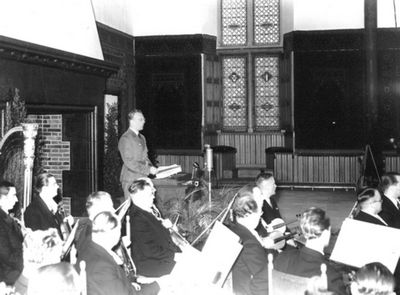 Seyss-Inquart at his inauguration in the Ridderzaal (Knight’s Hall) in The Hague. Source: ANP fotoarchief.
Seyss-Inquart at his inauguration in the Ridderzaal (Knight’s Hall) in The Hague. Source: ANP fotoarchief.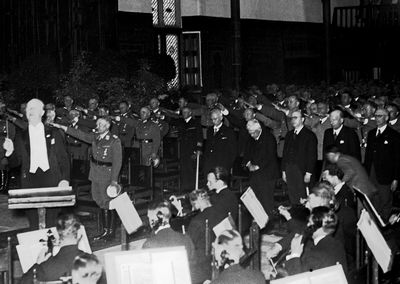 German functionaries present the Hitler salute during Seyss-Inquart’s inauguration. Source: ANP fotoarchief.
German functionaries present the Hitler salute during Seyss-Inquart’s inauguration. Source: ANP fotoarchief.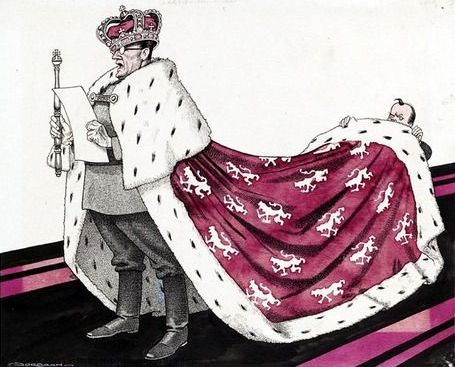 Cartoon of Seyss-Inquart by the cartoonist L.J. Jordaan. The cloak of the new “king” is carried by NSB-leader Anton Mussert. Source: Atlas van Stolk, Rotterdam.
Cartoon of Seyss-Inquart by the cartoonist L.J. Jordaan. The cloak of the new “king” is carried by NSB-leader Anton Mussert. Source: Atlas van Stolk, Rotterdam.Reconciliation Efforts
As it suited a man with his power, Seyss-Inquart had to move into a noble residence. The royal palaces were at his disposal, but he was tactful enough to realize that moving into one of them, would stir strong feelings with the Dutch people. The choice fell on the seventeenth-century estate Clingendael between The Hague and Wassenaar (nowadays the residence of the Dutch Institute for International Relations). He had some renovations installed and moved in, in the fall of 1940. Unlike many high-ranking Nazis, who indulged too freely in all the luxury that was available to them, Seyss-Inquart’s lifestyle was very modest. It was not a place for exuberant parties and, in case of a reception, inebriety was not tolerated and only soberly dinners were served to the guests.
Although it was more difficult or almost impossible to buy luxury products during the occupation, buying products on the black market was out of the question for Seyss-Inquarts’ kitchen staff. The story goes that when the office of the Befehlshaber der Sicherheitspolizei received an invitation for a diner at Clingendael , one said to each other that first something should be eaten elsewhere otherwise their hunger would not be appeased.
The austerity of the meetings in Clingendael did entirely fit with the character of the Reich Commissioner, who rather preferred listening to classical music or taking a walk, than bragging about his power or wealth. Unlike a lot of opportunists within the Nazi hierarchy he never abused his position to enrich himself. He was a modest, uncommunicative man. A workaholic with a great interest for culture. Moreover he was very intelligent, as shown by the result of an IQ score of 141 which he obtained during an inquiry while he was imprisoned in Nuremberg, after the war (only the former National Bank Director and Minister of Economics Hjalmar Schacht had a higher score). He was very far distanced from the stereotype of the brutal, power-hungry, corrupt Nazi.
His modest, introvert attitude was not always appreciated by his colleagues. "When I spoke with him, I always felt as if a glass wall was between us," declared the head of his Präsidialabteilung(similar to the Dutch public prosecutor) after the war. Friedrich Wimmer called him "a big silent one. He rarely gave his frank opinion". In 1942, Otto Bene, the representative of the German Ministry of Foreign Affairs in the Netherlands, called him a "the cool calculator ". According to Hanns Rauter, the Reich Commissioner, he was "a man without a heart" and Friedrich Christiansen described him as "an icy Jesuit". The latter description was based on the rumour that he would have been raised at a notorious Austrian Jesuit boarding school. This story was not true, but Seyss-Inquart adhered to the Catholic belief throughout his Nazi career, although he no longer attended church since the Anschluss. He paid his church tax through an intermediary and his youngest daughter was raised catholic.
A large part of his religion had been replaced by the national socialism. His initial reluctance towards Nazism in Poland was already long, which was proven by a speech he held in Poland in August 1939. "Our faith is crowned by the Trinity: People, Empire and Führer", as he spoke. "And therefore, for a national socialist, there should be no stronger bond than the one with his people. If the final and decisive mandate will be given, all will have to yield: our own destiny, our family, our opinion, our belief. Only those who are prepared to give their full commitment , in all circumstances and against all opposition, is a National Socialist ".
Now Seyss-Inquart had to win over the Dutch for these ideas. He realized that he first had to win them over for himself and started a sort of charm offensive, from which the Dutch would have to conclude that the Germans only had good intentions. One of Seyss-Inquart’ first official activities as Reich Commissioner was a visit to the graves of fallen Germans and Dutch soldiers on the Grebbeberg, where heavy fighting had taken place during the days in May. On June 21st, 1940, he also attended the presentation of the plans for the rebuilding of Rotterdam, which had been bombed by the Luftwaffe.
Other attempts by Seyss-Inquart in order to win over the Dutch people, were children's programs and the Winter Aid. The children's programs were his initiative to thank the Dutch for taking care of Austrian malnourished children in the years prior to the war. On June 22nd, 1940, he announced that 6,000 children from the bombed city of Rotterdam were offered a holiday in Austria. At least 6,753 children made use of his offer. In consideration of propaganda, the Reich Commissioner attended the departure of a train full with children on their trip to Austria in July. He presented himself as a true lover of children and let himself be photographed, surrounded by children. On October 1st, 1940, he was also present to welcome the children, who came home to Rotterdam. However, the Dutch were not so easy to deceive by this propaganda trick. It were mainly pro-German Dutch and NSB members, who let their children travel to Austria. One year later, when the initiative was repeated, only 525 children boarded the train.
The "Stichting Winterhulp Nederland" (WHN or Dutch Foundation for Winter Aid) was founded by Seyss-Inquart on October 28th, 1940. The organization was similar to the German Winterhilfswerk. The purpose was to centralize the existing charitable work in the Netherlands. "To provide the needy Dutch citizens with help and support, without regard of persons". It should have looked as a gesture of social affection of the occupying forces, but was not experienced like that by many Dutch people. They were angry because the organization took the place of private charities and the Dutch considered it a propaganda stunt. The occupational administration had tried to prevent the "Stichting Winterhulp Nederland" to be regarded as a national socialist initiative, but the involvement of prominent members of the NSB, like Max Blokzijl and Meinoud Rost van Tonningen and the many pro-German persons and NSB members amongst the collectors, gave a very different notion of it all.
A new opportunity to win over the Dutch was the collective struggle against communism, at least that is what Seyss-Inquart thought. In fact, in the civilian Netherlands, the fear of communism was big, especially among the religious population. After the launch of Operation Barbarossa, the German attack on the Soviet Union, on June 22nd, 1941, the Reich Commissioner organized a big demonstration on June 27th at the skating club site (the actual Museumplein) in Amsterdam under the motto: "Mit Adolf Hitler in ein neues Europa " (together with Adolf Hitler in a new Europe). During the speech of about one hour, the Dutch were to make a choice between National socialism or Bolshevism.
During the subsequent years of occupation the Dutch were swamped with anti-communist propaganda and they were called to serve in the Waffen-SS. Eventually around 22,000 Dutch enlisted voluntary for the Waffen SS. More than 7,000 of them were killed in action. On the home front, the survivors could count on little or no sympathy at all, they were regarded as traitors and were cold-shouldered. Many Dutch people considered not the Bolshevism as the immediate enemy, but the national socialism as the immediate enemy, although they did not always express this in a clear way.
Despite his attempts for reconciliation, Seyss-Inquart did not succeed to win over the Dutch people in mass. The relative moderation of the occupational administration during the early months was not maintained. Actions were required against the (armed) resistance; Dutchmen had to be transferred to Germany for compulsory labour and the Dutch Jews were deported to concentration and extermination camps in the east. As the highest representative of the enemy, Seyss-Inquart was held personally responsible, by many Dutch, for any unpopular measure. Even all crimes committed by the SS and police government of Hanns Rauter, were imputed to him, sometimes justly, sometimes unjustly. Obviously, because he showed himself in public practically always in the uniform of the SS. On April 20st, 1941, he was appointed SS Obergruppenführer; the same rank such as Reinhard Heydrich.
Although he was regarded, by many Dutch, as the personification of the enemy, his personality did not seem to have excited fear. This is in contrast to the Höhere SS und Polizeiführer. "Many jokes have been made about Seyss-Inquart," as stated historian Loe de Jong, "but not a single one about Rauter." It was his appearance and his handicap which made the Reich Commissioner the mockery-stock. Due to his intellectual appearance and his stiff leg, he simply made less of an impression than Rauter with his tall figure and his military appearance. As a joke, Seyss-Inquart was often called, "Six-and-a-quarter". Also it was said that, in the Hague, the existing streets were named after him : "de Lange Poten" (the long legs) and "de Korte Poten" (the short legs). Another well-known joke: "Hello little woman" Seyss-Inquart is supposed to have said to his wife when he returned home, while his wife answered with "Hello shorty" (which was supposed to refer to his one shorter leg). Also in cartoons of the illegal press, he was often mocked at.
Definitielijst
- communism
- Political ideology originating from the work of Karl Marx “Das Kapital” written in 1848 as a reaction to the so-called class struggle between the proletariat (labourers) and the bourgeoisie. According to Marx the proletariat would take over power from the well-to-do classes though a revolution. The communist movement aspires an ideal situation where the means of production and the means of consumption are common property of all citizens. This should end poverty and inequality (communis = common).
- Führer
- German word for leader. During his reign of power Adolf Hitler was Führer of Nazi Germany.
- Jews
- Middle Eastern people with own religion that lived in Palestine. They distinguished themselves by their strong monotheism and the strict observance of the Law and tradition. During World War 2 the Jewish people were ruthlessly persecuted and annihilated by the German Nazis. . An estimated 6,000,000 Jews were exterminated.
- Luftwaffe
- German air force.
- national socialism
- A political ideology drawn up by Hitler based on the superiority of the German race, the leader principle and fierce nationalism that was fed by the hard Peace of Versailles. National socialism was anti-democratic and racist. The doctrine was elaborated in Mein Kampf and organised in the NSDAP. From 1933 to 1945 National socialism was the basis of totalitarian Germany.
- Nazi
- Abbreviation of a national socialist.
- Nazism
- Abbreviation of national socialism.
- NSB
- National Socialist Movement. Dutch political party sympathising with the Nazis.
- offensive
- Attack on a smaller or larger scale.
- propaganda
- Often misleading information used to gain support among supporters or to gain support. Often used to accomplish ideas and political goals.
- resistance
- Resistance against the enemy. Often also with armed resources.
- socialism
- Political ideology aiming at slight or no class differences. Means of production are owned by the state. Evolved as a response to capitalism. Karl Marx tried to substantiate socialism scientific.
- Soviet Union
- Soviet Russia, alternative name for the USSR.
- Waffen-SS
- Name of Military section of the SS.
Images
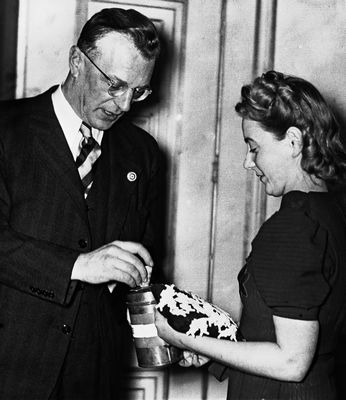 Seyss-Inquart puts his donation for the winter help work in the collection box. Source: ANP fotoarchief.
Seyss-Inquart puts his donation for the winter help work in the collection box. Source: ANP fotoarchief.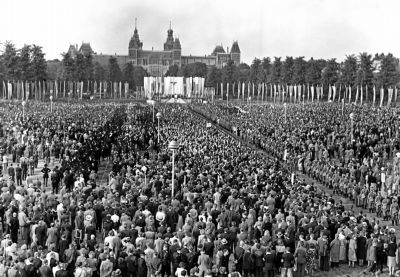 Manifestation against the bolshevism on 27 June 1941 in Amsterdam. Source: ANP fotoarchief.
Manifestation against the bolshevism on 27 June 1941 in Amsterdam. Source: ANP fotoarchief.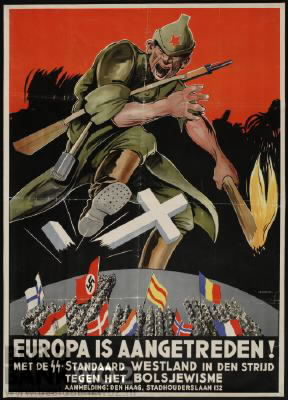 Propaganda poster that calls up the Dutch to join the SS-Standaard Westland to fight against the bolshevism. Source: Beeldbank WO2.
Propaganda poster that calls up the Dutch to join the SS-Standaard Westland to fight against the bolshevism. Source: Beeldbank WO2.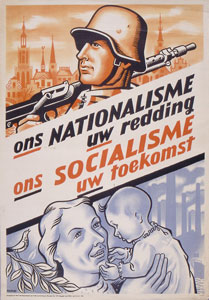 Propaganda poster of the NSB to win over the Dutch for national socialism. Source: Beeldbank WO2.
Propaganda poster of the NSB to win over the Dutch for national socialism. Source: Beeldbank WO2.Nazification of the Netherlands
The unpopularity of Seyss-Inquart also had to do with the fact that he did not come up to the expectations regarding the promises, made by him during his inaugural speech. The Dutch were subjected to an extensive German administration and their freedom became more and more restricted. Even before Seyss-Inquart was appointed in the Netherlands, both the radio and the General Dutch Press Agency (ANP) were placed under German supervision on May 15th,1940. Freedom of the press was put to an end and, during the occupation, the media were used for German propaganda. The existing radio associations were dissolved and replaced, in March 1941,by the "Nederlandse Omroep " (Dutch Broadcasting; NO). In May 1943, all radios were confiscated, in order that no one could listen to broadcasts of Radio Oranje from London anymore. The press was integrated in the Nederlandse Kultuurkamer (Dutch Chamber of Culture; NKK), established in November 1941. Everyone who was involved in film making, art, theatre and dance, literature and music was obliged to join. In the same way, for example, the unions ("Nederlandse Arbeidsfront" or Dutch Labour Front) and agriculture ("Nederlandsche Landstand" or Dutch Country class) were subjected to Nazification.
The NSB played an important role during the Nazification of the Netherlands. For example, it were often NSB members, which formed the executives within Nazified institutions. On December 14th, 1941, Seyss-Inquart declared the NSB to be the only political party allowed in the Netherlands. Two days earlier, NSB leader Anton Mussert took his personal oath on Hitler in Berlin, in the presence of Seyss-Inquart and Martin Bormann. Although Mussert collaborated with the Nazis, he differed of opinion with Seyss-Inquart. The Reich Commisioner preferred to see the Netherlands as part of Great- Germany, in the future. The NSB leader, however, would like to unite the Netherlands and Flanders under a pro-German, but independent administration.
In December 1942, Seyss-Inquart, Schmidt and Mussert paid a visit to Hitler in order to discuss the future of the Netherlands. The result was disappointing for Mussert. As long as the war continued, the power of governance in the Netherlands would not be transferred to the NSB, as the Reich Commissioner stated in the Concertgebouw in Amsterdam, after his return from Germany. He would be continuing his function until the end of the war. However, Hitler had promised that, in the new Europe, the Dutch could count on the same rights and opportunities as the Germans. Furthermore, during his speech Seyss-Inquart emphasized that Hitler had recognized Mussert as the advocate of national socialism in the Netherlands.
The NSB leader was officially appointed to "Leider van het Nederlandsche Volk" (leader (in German: Führer) of the Dutch people).The title sounded consequential, but had little practical significance. Mussert was involved in governance issues, but the final decisions were made by Seyss-Inquart. However, Mussert did get the approval to establish a "Secretary of State". This was a kind of shadow government, to inform the Reich Commissioner, but it had no political influence.
The fact that the wish of Mussert, to get more involved in the national government, was not realized was partly due to the way he was looked at by the occupational administration. Within the Reich Commissariat it was especially Hanns Rauter who had a great aversion against Mussert and his Great Dutch ideal, but also Seyss-Inquart had little regard for the NSB leader. Once he called him, contemptuously, a "liberal nationalist with an attempt to fascist methods". In his turn, Mussert thought the Reich Commissioner to be elusive and had more confidence in Fritz Schmidt, who rather liked a power increase of Mussert, but when, in the beginning of 1943, his attempts to increase the influence of the NSB leader ended up in a conflict within the Reich Commissariat, Seyss-Inquart ultimately chose the side of Rauter. The majority of the Dutch did not accept Mussert as a leader. He and his party were not beloved. The party never succeeded in obtaining more than 100,000 members in a population of around 9 million.
Much greater was the popularity of the royal family, which fled to London. This became clear on June 29th, 1940, the anniversary of Prince Bernhard, when the Dutch massively expressed their Orange inclination in various ways. Amongst other places, that day, in order to make a flower salute, they gathered near the royal palaces Noordeinde and Soesterberg and at monuments, erected at the honour of deceased members of the royal family. In some places the Dutch flag was raised and people decorated their bike in orange. Because many Dutch wore a carnation in their buttonholes, a trademark of Prince Bernhard; this day became known in history as "Anjerdag" (carnation day).
The next day it was quiet again, but to prevent a recurrence Seyss-Inquart did forbid demonstrations on anniversaries of the House of Orange. Also the Dutch were not allowed to listen to other radio stations than Dutch and German ones, because the Germans suspected that they would be educated to wrong intentions by other radio stations. This and other measures had effect, for on August 31st, 1940, the sixtieth birthday of Queen Wilhelmina, nowhere on the streets Queen's Day was celebrated. However, the Orange loyalty did not disappear, it continued in the living rooms and underground.
Definitielijst
- Führer
- German word for leader. During his reign of power Adolf Hitler was Führer of Nazi Germany.
- national socialism
- A political ideology drawn up by Hitler based on the superiority of the German race, the leader principle and fierce nationalism that was fed by the hard Peace of Versailles. National socialism was anti-democratic and racist. The doctrine was elaborated in Mein Kampf and organised in the NSDAP. From 1933 to 1945 National socialism was the basis of totalitarian Germany.
- NSB
- National Socialist Movement. Dutch political party sympathising with the Nazis.
- propaganda
- Often misleading information used to gain support among supporters or to gain support. Often used to accomplish ideas and political goals.
- socialism
- Political ideology aiming at slight or no class differences. Means of production are owned by the state. Evolved as a response to capitalism. Karl Marx tried to substantiate socialism scientific.
Images
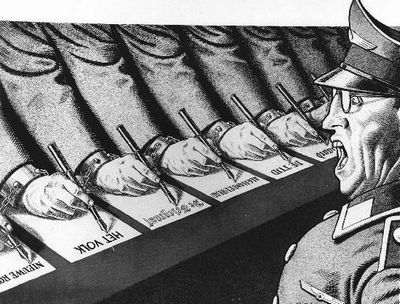 Cartoon which shows the obedience of the Dutch media to the German leadership. Source: ANP fotoarchief.
Cartoon which shows the obedience of the Dutch media to the German leadership. Source: ANP fotoarchief.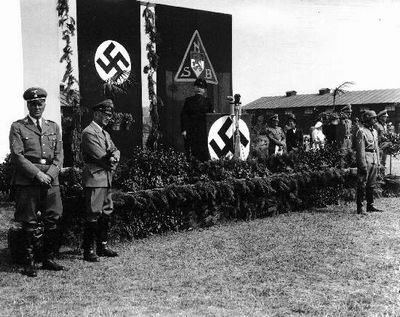 Mussert speaks on 15 August 1943 during the inauguration of members of the Landwacht. Standing on the left are Hanns Rauter and Seyss-Inquart. Source: ANP fotoarchief.
Mussert speaks on 15 August 1943 during the inauguration of members of the Landwacht. Standing on the left are Hanns Rauter and Seyss-Inquart. Source: ANP fotoarchief.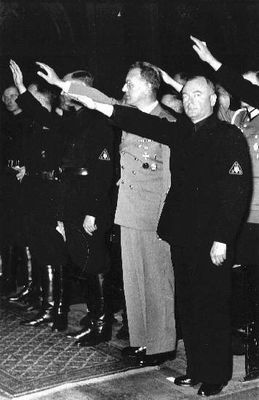 Anton Mussert and Seyss-Inquart present the Hitler salute. The Hague, 15 December 1942. Source: ANP fotoarchief.
Anton Mussert and Seyss-Inquart present the Hitler salute. The Hague, 15 December 1942. Source: ANP fotoarchief.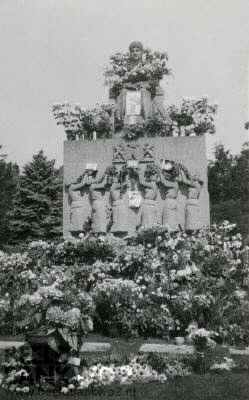 The Queen Emma Monument in Amsterdam overwhelmed with flowers on Anjerdag (Carnation Day), 29 June 1940. Source: Beeldbank WO2.
The Queen Emma Monument in Amsterdam overwhelmed with flowers on Anjerdag (Carnation Day), 29 June 1940. Source: Beeldbank WO2.Oppression and persecution
The Jews were part of the population that certainly did not have to count on the conciliatory words of Seyss-Inquart in his inaugural speech. The first months it looked as if they would be left undisturbed, until the autumn of 1940, when the first anti-Jewish measures were taken.
In September, nearly all Jewish newspapers were closed down and in October, companies with Jewish owners or companies with a predominant Jewish interest were placed under the supervision of a Verwalter (agent). That same month also the dismissal of all Jewish officials was started. On January 10th, 1941, Seyss-Inquart ordered that all "persons of wholly or partly Jewish blood" did have to register themselves. A measure that, finally, would have far-reaching consequences. Except from some schools and universities, which protested against the dismissal of Jewish teachers and professors, the anti-Jewish measures caused only little fuss. This situation changed when Seyss-Inquart and Rauter took harsh measures because of the escalating violence in Amsterdam, between Dutch Nazi sympathizers and Jewish Amsterdam citizens, supported by non-Jewish fellow citizens.
On February 11th, 1941, the Amsterdam NSB member, Hendrik Koot, got seriously injured in a brawl, in such a way that he died. On February 19th, a patrol of the Ordnungspolizei ran into an ambush in the ice cream parlour Koco. This ambush was actually set up for NSB members. As a result of these and other incidents the occupational administration choose for a tough approach. To set an example, on February 22nd and 23rd, a total of 427 Jewish men were transported to camp Schoorl. Infuriated about this, but also because of the discontent within the working community, the Communist Party of the Netherlands (CPN) called for a strike on February 25th and 26th (the February strike). The call was responded to in mass, in the capital city as well as in other cities. Whereas the Germans let the Anjerdag happen, they now did intervene. Strikers were arrested and they had even been shot at which caused some deaths. The order was restored on the second day of the strike.
Two weeks after the strike, Seyss-Inquart declared openly that the Jews would be taken care of. "We will hit the Jews where we can and those, who associate with them, will have to take the consequences", he assured. In November 1941, he charged Dr. Hans Böhmcker, his Beauftragte (representative) in Amsterdam, with the implementation of "solving the Jewish question". The preparations and the actions that resulted from it, would be important for the deportations of Jews, which were carried out from July 1942.
Finally, the SS was more involved in the deportation of Jews from the Netherlands, than Seyss-Inquart and his staff. However, he constantly kept tabs on these actions and was regularly informed about the progress in removing the Jews from the Netherlands. Without doubt he supported the deportation policy. In his book "Vier Jahre in den Niederlanden" (Four Years in the Netherlands) he wrote: "For us, the Jews are no Dutch. They are enemies, enemies with whom we neither have a truce nor will come to peace . [...] The Führer declared that the Jews in Europe have played their role, and so they really played their role". Finally, about 107,000 Jews were deported from the Netherlands, of whom only 5,450 survived the war.
After the February strike, it remained relatively quiet in the Netherlands for some time, until April 29th and 30th 1943, when strikes bursted out again at many places in the Netherlands. The cause for this was the announcement of Wehrmacht Befehlshaber Friedrich Christiansen, that all former soldiers of the Dutch army still were to go into captivity immediately, so they could be put to work in Germany according to the Arbeitseinsatz. At the same time the Netherlands were disposed of men who were capable to bear arms and who might join the Allies in their invasion, whenever possible. The announcement caused much dissatisfaction and practically in the entire Netherlands strikes were organized, although Amsterdam remained relatively calm since the suppression of the February strike had made a big impression. The occupational administration acted harsh: the police state law was promulgated and the strikes were precipitated with shootings, arbitrary arrests and summary executions of strikers.140 Dutch lost their lives. This relentless attack had the desired effect, because on May 3rd, most of the strikers were back to work again.
On May 19th, 1943, Seyss-Inquart held a speech, during half an hour, in the large factory building of Stork in Hengelo. It was a symbolic place, because in this very company, the outbreak of the April / May strike took place. According to the Haagsche Courant (newspaper) 7,000 people attended the meeting, but in reality it were a lot less. Moreover, prior to the speech, German workers from Gronau, just across the border, were brought in by train, to attend the speech.
Again, the Reich Commissioner presented himself as a moderate politician and expressed the hope "that [his] relations with the Dutch are not guided by the arguments of arms, but by the arguments of rational considerations". He explained why the Dutch soldiers were taken into captivity and justified the harsh approach, which seemed to be necessary in order to regain peace and order. In his opinion, the Dutch should be glad that the number of casualties turned out lower than expected and that the Wehrmacht was not called in. Next he warned about the senselessness of an Allied victory, because that "would especially become the extradition to Judaism" and "[...] that is the guaranteed road to Bolshevism." The Dutch were better to join the Germans in going to war, "to the salvation of the Führer".
The next day a Dutch translation of his speech was published in the Dutch newspapers, which could not convince the Dutch anymore, because the occupying forces had already clearly shown his true nature. During the last year of the occupation, the popularity of the occupational administration would decrease to a minimum, which mainly could be blamed on the so-called Hunger Winter.
Definitielijst
- Arbeitseinsatz
- “Labour deployment”. Forced deployment in the German industry. Approximately 11 million European citizens were rounded up and deployed into forced labour in the Third Reich. Not to be confused with the Arbeidsdienst or labour service, an organisation for national-socialist education for Dutch youngsters.
- February strike
- Anti-German demonstration in the Netherlands during 25 and 26 February 1941. Direct cause was the violent razzia by the WA and German soldiers in the Jewish quarter of Amsterdam.
- Führer
- German word for leader. During his reign of power Adolf Hitler was Führer of Nazi Germany.
- invasion
- Armed incursion.
- Jews
- Middle Eastern people with own religion that lived in Palestine. They distinguished themselves by their strong monotheism and the strict observance of the Law and tradition. During World War 2 the Jewish people were ruthlessly persecuted and annihilated by the German Nazis. . An estimated 6,000,000 Jews were exterminated.
- Judaism
- Monotheistic religion developed among the ancient Hebrews.
- Nazi
- Abbreviation of a national socialist.
- NSB
- National Socialist Movement. Dutch political party sympathising with the Nazis.
- Wehrmacht
- German armed military forces, divided in ground forces, air force and navy.
Images
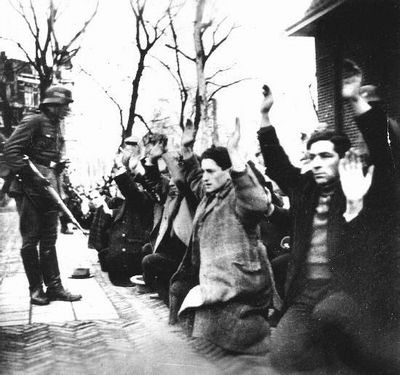 Razzia in the Jewish quarter on 22 February 194. Captured Jews on the Jonas Daniel Meijer square in Amsterdam. Source: ANP fotoarchief.
Razzia in the Jewish quarter on 22 February 194. Captured Jews on the Jonas Daniel Meijer square in Amsterdam. Source: ANP fotoarchief.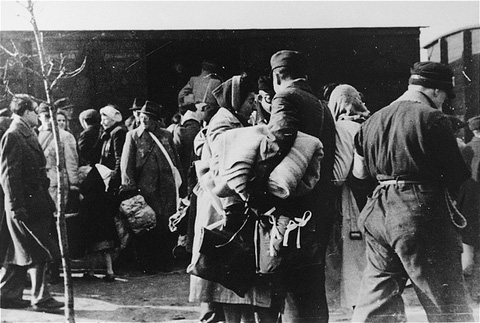 Deportation of Jews from camp Westerbork. Source: USHMM.
Deportation of Jews from camp Westerbork. Source: USHMM.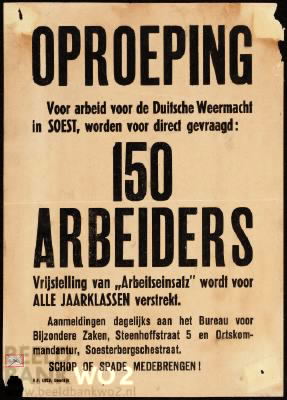 Draft order for the Arbeitzeinsatz. Source: Beeldbank WO2.
Draft order for the Arbeitzeinsatz. Source: Beeldbank WO2.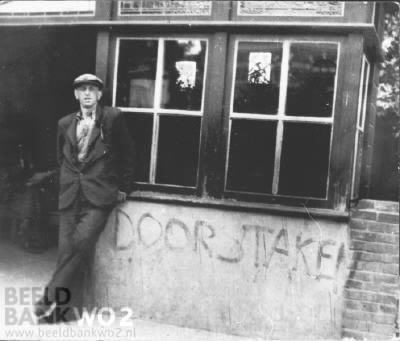 A striker during the April/Mai strike. Source: Beeldbank WO2.
A striker during the April/Mai strike. Source: Beeldbank WO2.Last year of the occupation
On June 6th, 1944, Allied troops landed on the beaches of Normandy and the start of the liberation of Western Europe was to begin. On August 25th, Paris was liberated, and shortly thereafter, on September 4th, 1944, Antwerp. Because the occupying forces and collaborators in the Netherlands expected the Allies to invade the Netherlands very soon, they panicked. On September 4th, Seyss-Inquart announced the state of emergency, which did only increase the panic. On Tuesday, September 5th, now known as "Mad Tuesday", Dutch collaborators, in mass, fled to the east, while the rest of the Netherlands already was preparing to welcome the liberators festively. It is true that, on September 12th, U.S. troops did set foot on Dutch soil and Maastricht was liberated during the next two days, but for the larger part of the Netherlands, still six difficult months were in prospect, before the liberation was a fact.
The occupying forces got extremely annoyed about the outburst of joy, that had occurred when it was thought that the liberation was imminent. After the German victory, the Netherlands no longer could rely on a privileged position in the New Europe. The efforts of Seyss-Inquart to win over the Netherlands to national socialism finally came to an end. Both the influence of the Wehrmacht and the SS on the occupational policies increased.
The German army forced Dutch men to build defences and during raids in major cities, in the west and in the Noordoostpolder, 120,000 men were arrested for the Arbeitseinsatz in Germany. Since May 1940 Dutch were already sent to Germany to replenish the shortage of labour force. Between 1940 and 1944, approximately 387,000 Dutch men were employed in Germany, often in the war industry. This happened under the command of Generalbevollmächtigter für den Arbeitseinsatz, Fritz Sauckel, but with the cooperation of Seyss-Inquart and his staff.
After September 1944, not only labour force, but also materials were transported to Germany in more and more increasing quantities. Even complete factories and port equipment were dismantled, in order to have the inventory and materials available for Germany. This looting had already begun on a smaller scale; among others, the property of Jews and other "enemies of the state" had been confiscated. The Reich Commissariat cooperated with the Einsatzstab Rosenberg (support unit), an organization, that among other things, dealt with the appropriation of Jewish household effects in Belgium, the Netherlands, which would be used by the Nazi government in Eastern Europe.
The Allied landing in Normandy and the subsequent Allied victories created new motivation for the Dutch resistance movement. Höhere SS und Polizeiführer Hanns Rauter took up total terror in order to suppress the resistance. For this, he willingly made use of the Niedermachungsbefehl, issued by Hitler in the summer of 1944. In this order was stated that arrested members of the resistance no longer had the right of a trial: resistance members, who appeared to be armed at their arrest, were to be shot on site or transferred to the Sicherheitspolizei. Seyss-Inquart was aware of the ruthless repression of the resistance and usually gave his consent to the actions, although it should be mentioned that he reduced the number of death sentences several times.
His role in the retaliatory measures, after the accidental attack on Rauter in the night of March 6th to 7th, 1945, is not entirely clear. According to SS Brigadeführer Eberhard Schöngarth, Befehlshaber der Sicherheitspolizei und des SD in the Netherlands from June 1st, 1944, Seyss-Inquart ordered him to execute 200 Todeskandidaten (death row inmates who were kept alive until an appropriate time for their execution). Seyss-Inquart claimed that this order was not his, but Heinrich Himmler’s. He had ordered Seyss-Inquart to shoot 500 prisoners. Ultimately, as a reprisal for the attack on Rauter, 274 Dutch people were executed.
Besides the strongly increased Arbeitseinsatz and the total terror of the SS, the Hunger Winter in particular inflicted deep wounds. Seyss-Inquart was significantly involved in the creation of this food crisis. The prelude to the Hunger Winter began when the Dutch government in London, on September 17th, 1944, called for a general railway strike in support of Operation Market Garden. This allied operation took place from September 17th to 25th and its purpose was to advance from the Dutch south border towards Arnhem and subsequently invade Germany. The railway strike was to obstruct the German warfare. To the big surprise of the Germans, the response to this call for strike was massive. Even after the allies had failed to liberate Arnhem, the strike continued until the liberation of the Netherlands in May 1945.
The Germans took measures and got railway staff from Germany in order to secure the transports of goods to the Reich. All other traffic was sacrificed to this action. In addition, as retaliation, Seyss-Inquart decided to block the inland shipping. His intention by this was to exercise pressure on the people and the strikers. Thus, the densely populated west became cut off from food and fuel supplies. This conflicted with the policies Seyss-Inquart proclaimed previously. He had aimed to keep the food supply in the Netherlands well organized. When Hermann Göring, as plenipotentiary for the Four Year Plan in August 1942, demanded one million tonnes of vegetables form the farmers in the Netherlands, the Reich Commissioner did not give in. However, non-edible products such as agricultural seeds, reeds, straw and coffee, tea and rice supplies have been delivered to Germany in large quantities.
The shipping blockade was abolished after six weeks, but out of fear that their ships would be requisitioned and be shelled by the Allies, the skippers refused to return to work. Only after Seyss-Inquart promised his full cooperation, shipping temporarily got going. However, in December, it started to freeze and both the canals and rivers as well as the IJsselmeer became unnavigable. It would take until mid-February before shipping was possible again. That very winter, the impact to the people in the densely populated west of the Netherlands was big. City dwellers moved in mass to the countryside in search of food. In order to keep themselves warm in that cold winter they even burned their furniture. Diseases like hunger oedema, tuberculosis and scabies did break out, due to undernourishment and one-sided food and deteriorating sanitary conditions. A lot of children got ill from dysentery and diphtheria. More than 200,000 people had to be treated in hospitals, due to malnutrition. The estimation is that between 20,000 and 22,000 people died from malnutrition, disease and exhaustion. The food situation in the rest of the Netherlands was far less acute; the south was liberated and in the occupied north and east farms provided food supply.
Although Seyss-Inquart had had an important share in the development of the food crisis, he made several attempts to improve the situation. For example, although the shipping embargo was still valid, he allowed thousands of men to cross the IJsselmeer from the west to dig up potatoes at the other side and when, in January 1944, the Central Kitchens ran out of food supplies, he had potatoes brought to the west by train. On April 30th, 1945, he consulted with Walter Bedell Smith, Chief of Staff of the Supreme Allied Commander, Dwight Eisenhower, about the the conditions for a ceasefire. Also an agreement had been made on allied food droppings. At that time Seyss-Inquart showed his moderate face again; he not only consulted with the Allies; he also refused to carry out Hitler's Nero-command of March 19th, 1945. This order meant the destruction of the (industrial) infrastructure according to the strategy of the scorched earth.
The very last days before the fall of the Third Reich, Seyss-Inquart still presented himself as a determined advocate of Germany, loyal to Adolf Hitler, who committed suicide on April 30th, 1945, in his bunker in Berlin. On May 2nd, 1945, his reaction to the death of the German dictator was published in the Algemeen Handelsblad. "We are now in a desperate struggle" the Reich Commissioner stated. "Our first soldier and defender in this struggle has perished. Let our enemies triumph and think to have overwhelmed us. Now, after the heroic death of our Führer, we will never stop fighting. We believe in Germany. Only when we have won our freedom, we will stop fighting. Veil the image of the Führer with mourning. Bring him flowers, the one who made our lives proud and worth living".
They were only empty words, because two days later, on May 4th, 1945, Field Marshal Bernard Montgomery accepted the surrender of the Wehrmacht in Northwest Europe. A day later negotiations on the surrender of German troops in the Netherlands took place in hotel De Wereld (the world) in Wageningen. The following day, May 6th, Generaloberst Johannes Blaskowitz signed the capitulation of his forces in the Netherlands. On May 7th, Generaloberst Alfred Jodl signed, on behalf of the German government, unconditional surrender of all German forces. All hostilities had to cease before midnight on May 8th. The war in Europe was over.
Definitielijst
- Arbeitseinsatz
- “Labour deployment”. Forced deployment in the German industry. Approximately 11 million European citizens were rounded up and deployed into forced labour in the Third Reich. Not to be confused with the Arbeidsdienst or labour service, an organisation for national-socialist education for Dutch youngsters.
- capitulation
- Agreement between fighting parties concerning the surrender of a country or an army.
- Four Year Plan
- A German economic plan focussing at all sectors of the economy whereby established production goals had to be achieved in four years time.
- Führer
- German word for leader. During his reign of power Adolf Hitler was Führer of Nazi Germany.
- Jews
- Middle Eastern people with own religion that lived in Palestine. They distinguished themselves by their strong monotheism and the strict observance of the Law and tradition. During World War 2 the Jewish people were ruthlessly persecuted and annihilated by the German Nazis. . An estimated 6,000,000 Jews were exterminated.
- Marshal
- Highest military rank, Army commander.
- mid
- Military intelligence service.
- national socialism
- A political ideology drawn up by Hitler based on the superiority of the German race, the leader principle and fierce nationalism that was fed by the hard Peace of Versailles. National socialism was anti-democratic and racist. The doctrine was elaborated in Mein Kampf and organised in the NSDAP. From 1933 to 1945 National socialism was the basis of totalitarian Germany.
- Nazi
- Abbreviation of a national socialist.
- railway strike
- This was announced on the radio and complied with by the Dutch railway staff on 17 September 1944. The railway strike was intended to support the allied plan Operation Market Garden. After the allied airborne landings had failed, Dutch railway staff remained on strike until the liberation.
- resistance
- Resistance against the enemy. Often also with armed resources.
- socialism
- Political ideology aiming at slight or no class differences. Means of production are owned by the state. Evolved as a response to capitalism. Karl Marx tried to substantiate socialism scientific.
- strategy
- Art of warfare, the way in which war should be conducted in general.
- Wehrmacht
- German armed military forces, divided in ground forces, air force and navy.
Images
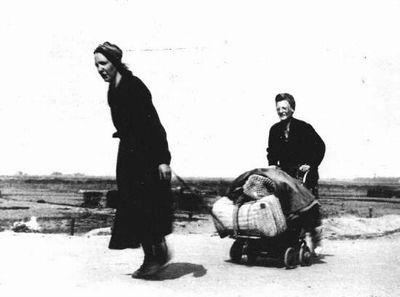 Hunger march during the Hunger winter, somewhere between Utrecht and Amsterdam, 1 April 1945. Source: ANP fotoarchief.
Hunger march during the Hunger winter, somewhere between Utrecht and Amsterdam, 1 April 1945. Source: ANP fotoarchief.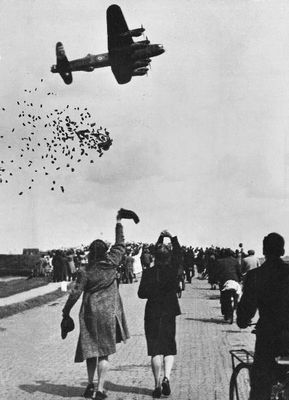 Food drop in the surroundings of Delft, 29 April 1945. The Lancaster bombers were warmly welcomed. Source: ANP fotoarchief.
Food drop in the surroundings of Delft, 29 April 1945. The Lancaster bombers were warmly welcomed. Source: ANP fotoarchief.Minister of Foreign Affairs and capitulation
Looking back at the career of Seyss-Inquart in the Netherlands, we are inclined to think that he failed to satisfy Hitler, since his mission to win the Dutch over to national socialism failed. On July 14th, 1944, he himself admitted that the biggest mistake had been to try to adapt the Dutch to the system of the occupying forces by means of assimilation. "In this, we tried to organize everything and to have everything functioning the way it is organized and functioning (at least should be functioning) with us", he said. "A consequence of this was that the population of the occupied territories had the impression to be patronized (geschulmeistert)".
It is very unlikely that, in the same period of time, somebody else would have managed to win over the Dutch for national socialism. If anyone was to succeed in the Netherlands, it would be the diplomatic Seyss-Inquart and not the much more aggressive Rauter or unpopular Mussert. The Dutch national character and the developments in the war, next to the German policy, more or less led to the failure of the nazification of the Netherlands.
Yet the assumption that Seyss-Inquart failed in his function as Reich Commissioner is too bluntly. Finally he succeeded in deploying the Dutch economy for the German war industry. The Dutch business was benefitted from German orders and in the first half of 1944, nearly all exports, worth 50.5 million (from a total of 58.2 million Guilder), were shipped to Germany. Most Dutch refused to submit to assimilation, but only a minority turned to armed resistance against the occupying forces. The February strike and the April / May strikes were expressions of discontent, no serious attempts to defeat the occupying forces . Those who have picked up the weapons did do so especially in the last year of the war. During the first four years of occupation there was no permanent commotion in the Netherlands and during the last year of the war, the armed resistance was definitely not of the same magnitude as for example in France and Poland. From a German point of view, therefor, Seyss-Inquart did not do such a bad job.
For his commitment and performance Seyss-Inquart was highly appreciated by Hitler. In February 1942 the Führer praised him as "extremely intelligent [...], slippery as an eel, friendly and in the same time, thick skinned and tough". Three months later Hitler praised his diplomatic skills, when he stated that "the Viennese [...] with their friendly nature, were better at doing certain things than anyone else". In the summer of 1943 Hitler told his minister of propaganda, Joseph Goebbels, that Seyss-Inquart "rules the Netherlands extremely skilled and flexible; he changes softness in a smart way and displays the best Austrian training". When Hitler, shortly before his suicide, made his will, incorporating a new government under Grossadmiral Karl Doenitz, he appointed Seyss-Inquart as Minister of Foreign Affairs. This as a replacement of Joachim von Ribbentrop, who had had only little or no political influence during the last four years.
On May 1st, 1945, Seyss-Inquart travelled by Schnellboot across the North Sea to … ? in order to report to Reich president Dönitz at his headquarters in Flensburg, Schleswig-Holstein. There he was informed about his new function within the new government. Dönitz discussed the capitulation with Seyss-Inquart and other civil administrators and military commanders of territories, which were still occupied. Dönitz wanted to avoid useless bloodshed and actually wanted to agree upon a capitulation on the western front only. On the eastern front, he wanted, together with the Western Allies, continue the battle against the Soviet Union. Dwight Eisenhower did not sympathize with this idea and forced Germany to an unconditional surrender on all fronts.
On May 3rd, Seyss-Inquart tried to return to the Netherlands by Schnellboot, in order to, according to its own saying, to take care of his employees and to ensure accountability for his policies, but because of a severe storm, sailing was impossible. On May 7th, yet he began his journey to the Netherlands, while, during the time in between in Flensburg, he maintained contact with the Reich Commissariat, of necessity, by telegram. He did not get far, because in Hamburg, he was arrested by the British. Subsequently he was transferred to the Netherlands where he was imprisoned in Delden in the province of Overijssel.
Definitielijst
- capitulation
- Agreement between fighting parties concerning the surrender of a country or an army.
- Führer
- German word for leader. During his reign of power Adolf Hitler was Führer of Nazi Germany.
- national socialism
- A political ideology drawn up by Hitler based on the superiority of the German race, the leader principle and fierce nationalism that was fed by the hard Peace of Versailles. National socialism was anti-democratic and racist. The doctrine was elaborated in Mein Kampf and organised in the NSDAP. From 1933 to 1945 National socialism was the basis of totalitarian Germany.
- propaganda
- Often misleading information used to gain support among supporters or to gain support. Often used to accomplish ideas and political goals.
- resistance
- Resistance against the enemy. Often also with armed resources.
- socialism
- Political ideology aiming at slight or no class differences. Means of production are owned by the state. Evolved as a response to capitalism. Karl Marx tried to substantiate socialism scientific.
- Soviet Union
- Soviet Russia, alternative name for the USSR.
Images
Nuremberg
Together with 21 other high-ranking Nazi’s, Seyss-Inquart stood trial before the International Military Tribunal at Nuremberg, which took place from November 20st 1945 until October 1st 1946. Seyss-Inquart was charged with all four charges. These were: "1. Conspiracy to make a war of aggression or crimes against peace; 2. The conduct of a war of aggression; 3. War Crimes and 4. Crimes against humanity ".
During the interrogations he was hiding several times behind the argument that he could not be held responsible for the alleged crimes, because they had not been carried out on his command. For instance, the executions of hostages by the Sicherheitspolizei had been imposed directly by Hitler through a Führerbefehl, which could not be influenced by Seyss-Inquart.
Regarding the deportation of the Jews, Seyss-Inquart pointed out to the tribunal that this was a matter of the SS and that he was even not aware of the fact that Jews were systematically exterminated in Auschwitz. Taken his involvement in anti-Jewish measures and his high-ranking position, this statement was improbable, which was the opinion of the judges as well. Seyss-Inquart’s statement that he had been informed, by people he did sent to Auschwitz for further investigation, that the Jews were doing fairly well and that he supposed that they would be relocated somewhere else, after the war, was not believed, based on the evidence and his official position.
In his final deposition of August 31st, 1946, he emphasized that he was not an executioner nor a premeditated robber, as the Sovjet prosecutor had alleged. "My conscience is clear in the sense that the living conditions of the Dutch during the period I was responsible for it, until the middle of 1944, were better than during the First World War when the country was not occupied, nor subjected to a blockade. This is supported by the marriage and birth statistics and mortality and medical statistics. Most certainly it can be ascribed to the effects of a number of measures that I did proclaim, such as a comprehensive health insurance, premiums for married couples and children, progressive income tax rates and so on". The deportations of the Jews seemed justified to him, because, as he stated, "today, such deportations affect over 10 million Germans who are remaining in their home lands for centuries". In addition he acknowledged, that these Germans were not a victim of a systematic destruction program, but of a forced emigration, which also was applied by Nazi Germany to have ethnic Germans take the places of non-Aryan peoples.
He ended his final statement with an explanation about his attitude that he, as he felt, owed Hitler. To him, Hitler was "the man who made Great Germany to a fact in the German history. I have served this man. And now? Now I cannot exclaim, "Crucify him" because, yesterday, I was exclaiming "Hosanna". [...] My final word is the principle on which I have always acted and that I will remain faithful until my last breath: "I believe in Germany".
The tribunal granted that Seyss-Inquart was not directly responsible for all the crimes, committed under his influence, and admitted that he had been able to avoid some crimes, like carrying out Hitler's Nero command. Nevertheless, the Allied judges came to the conclusion that he "was well informed about all the news and thus he was a willing accomplice to war crimes and crimes against humanity committed during the occupation of the Netherlands" . He was found guilty for the sections 2, 3, 4, based on the fact that several crimes had been committed under his influence or by his order in Austria, Poland and the Netherlands. Therefore he was sentenced to death by hanging. The execution was carried out on October 16th,1946 in the prison in Nuremberg. At 2:57 hours the doctors declared that the former Reich Commissioner had departed this life.
See also: Final statement Seyss-Inquart Verdict Seyss-Inquart
Definitielijst
- Crimes against humanity
- Term that was introduced during the Nuremburg Trials. Crimes against humanity are inhuman treatment against civilian population and persecution on the basis of race or political or religious beliefs.
- First World War
- Took place from 1914 till 1918 and is also named The Great War. The conflict started because of increased nationalism, militarism and neo-colonialism in Europe. Two alliances battled one another during the 4-year war, which after a dynamic start, resulted into static trench warfare. The belligerents were the Triple Alliance (consisting of Great-Britain, France, and Russia; later enlarged by Italy and the USA, amongst others) on the one hand and the Central Powers (consisting of Germany, Austria-Hungary, Bulgaria and the Ottoman empire) on the other hand. The war was characterized by the huge number of casualties and the use of many new weapons (flamethrowers, aircraft, poison gas, tanks). The war ended in 1918 when Germany and its allies surrendered unconditionally.
- Jews
- Middle Eastern people with own religion that lived in Palestine. They distinguished themselves by their strong monotheism and the strict observance of the Law and tradition. During World War 2 the Jewish people were ruthlessly persecuted and annihilated by the German Nazis. . An estimated 6,000,000 Jews were exterminated.
- Nazi
- Abbreviation of a national socialist.
- War Crimes
- Crimes committed in wartime. Often concerning crimes committed by soldiers against civilians.
Images
Information
- Article by:
- Kevin Prenger
- Translated by:
- Chrit Houben
- Published on:
- 19-01-2025
- Feedback?
- Send it!
Related sights
Related books
Sources
- Grijs Verleden, Uitgeverij Contact, Amsterdam, 2008.
- EVANS, R.J., Het Derde Rijk deel 2, Spectrum, Utrecht, 2006.
- FRIEDLäNDER, S., Nazi-Duitsland en de Joden, Nieuw Amsterdam, Amsterdam, 2007.
- HEYDECKER, J.J. & LEEB, J., Opmars naar de galg, Scheltema & Holkema, Amsterdam, 1961.
- JONG, L. DE, Het Koninkrijk der Nederlanden in de Tweede Wereldoorlog 4, Staatsuitgeverij, Den Haag, 1969.
- KOK, R. & SOMERS, E., Nederland en de Tweede Wereldoorlog, Waanders, Zwolle, 2005.
- SPECTOR, S. & ROZETT, R., Encyclopedie van de Holocaust, Kok, Kampen, 2004.
- WISTRICH, R.S., Who's who in Nazi Germany, Routledge, Londen, 2002.
